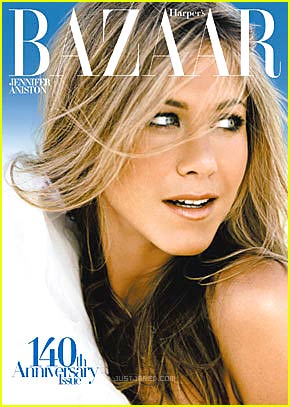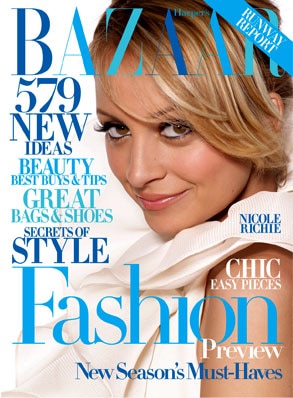
Harper's Bazaar is a well-known American fashion magazine, first published in 1867. Harper's Bazaar considers itself to be the style resource for "the well-dressed woman and the well-dressed mind".
Aimed at members of the upper-middle class and upper classes, Bazaar assembles photographers, artists, designers and writers to deliver a "sophisticated" perspective into the world of fashion, beauty and popular culture on a monthly basis.
History
Since its debut in 1867 as America's first fashion magazine, the pages of Harper's Bazaar, first called Harper's Bazar, has been home to talent such as the founding editor, author and translator Mary Louise Booth as well as:
- Fashion editors including Carmel Snow, Carrie Donovan, Diana Vreeland, Liz Tilberis, Alexey Brodovich, Brana Wolf
- Photography from Louise Dahl-Wolfe, Man Ray, Diane Arbus, Richard Avedon, Robert Frank, Inez van Lamsweerde, Craig McDean and Patrick Demarchelier,
- Illustrations by Erté (Romain de Tirtoff) and Andy Warhol.
- Writers Alice Meynell, Gloria Guinness, and Eleanor Hoyt Brainerd.

When Harper’s Bazaar began publication it was a weekly magazine catering to women in the middle and upper class. They showcased fashion from Germany and Paris in a newspaper design format. It wasn’t until 1901 that Harper’s moved to a monthly issued magazine which it maintains today. Now Harper's Bazaar is owned and operated by the Hearst Corporation in the U.S. and The National Magazine Company in the U.K. Hearst purchased the magazine in 1912.
Harper & Brothers founded the magazine. This company also gave birth to Harper's Magazine and HarperCollins Publishing.
Glenda Bailey is the editor-in-chief of U.S. Harper's Bazaar.
Victorian Elegance (1898-1912)
As the turn-of-the-century began in America, Harper's Bazaar began featuring both illustrations and photographs for its covers and inside features of high society and increasingly of fashion.
It's interesting to note that during this late Victorian period, as the women's suffrage movement was gaining momentum (American women did not all win the right to vote until 1920 with the passing of the 19th Amendment), the introduction of more tailored dresses and jackets coincided with women's new sense of feminism. Bazaar also began profiling prominent socialites, such as the Astors and the Griscoms.
The Avedon Years (1945-1965)
Richard Avedon began creating fashion portfolios for Harper's Bazaar at the age of 22. His distinctive photographs showed both chic insouciance and boundless vitality. Avedon's women leaped off curbs, roller-skated on the Place de la Concorde, and were seen in nightclubs, enjoying the freedom and fashions of the postwar era.

He was immortalized in the 1957 film Funny Face by the character Dick Avery (played by Fred Astaire), who asked, "What's wrong with bringing out a girl who has character, spirit, and intelligence?".
The Vreeland Years (1936-1962)
When Carmel Snow (former Vogue Editor) saw Mrs. T. Reed Vreeland dancing on the roof of New York's St. Regis Hotel in a white lace Chanel dress and a bolero with roses in her hair one evening in 1936, she knew she'd found Bazaar's newest staffer. Diana, who is said to have invented the word "pizzazz", first came to the attention of readers with her Why Don't You ... ? column. (A typical suggestion: "Why don't you ... wear, like the Duchess of Kent, three enormous diamond stars arranged in your hair in front?") Before long, she became fashion editor, collaborating with photographers Louise Dahl-Wolfe and Richard Avedon and, later, art director Henry Wolf. Her eccentricity, perception and wit, as well as her sharp wit and sweeping pronouncements ("I adore that pink! It's the navy blue of India", "Elegance is refusal!"), were memorialized in the movie Funny Face, making her, for many, the prototypical fashion-magazine editor.
Alexey Brodovitch (1934-1958)
In 1934, newly installed Bazaar editor Carmel Snow attended an Art Directors Club of New York exhibition curated by 36-year-old graphic designer Alexey Brodovitch and immediately offered Brodovitch a job as Bazaar's art director. Throughout his career at the magazine, Brodovitch, a Russian émigré (by way of Paris), revolutionized magazine design. With his directive "Astonish me," he inspired some of the greatest visual artists of the 20th century (including protégés Irving Penn, Hiro, and, of course, Richard Avedon). Brodovitch's signature use of white space, his innovation of Bazaar's iconic Didot logo, and the cinematic quality that his obsessive cropping brought to layouts (not even the work of Man Ray and Henri Cartier-Bresson was safe from his busy scissors) compelled Truman Capote to write, "What Dom Pérignon was to champagne ... so [Brodovitch] has been to ... photographic design and editorial layout." Sadly, Brodovitch's personal life was less triumphant. Plagued by alcoholism, he left Bazaar in 1958 and eventually moved to the south of France, where he died in 1971.
The Carmel Snow Years (1933-1957)
As of 1933, editor-in-chief Carmel Snow (a former editor at Vogue) brought photojournalist Martin Munkacsi to a windswept beach to shoot a swimwear spread. As the model ran toward the camera, Munkacsi took the picture that made fashion-magazine history. Until that moment, nearly all fashion was carefully staged on mannequin-like models in a studio. Snow's buoyant spirit (she rarely slept or ate, although she had a lifelong love affair with the three-martini lunch) and wicked sense of adventure brought life to the pages of Bazaar. Snow's genius came from cultivating the best people. Her first big find was art director Alexey Brodovitch, who innovated Bazaar's iconic Didot logo. Brodovitch is perhaps best known for his work with Richard Avedon, who, as a young photographer, was so determined to work at Bazaar that he endured the humiliation of 14 canceled interviews before finally being hired. Snow also unleashed the force of nature known as Diana Vreeland, whom she brought on as fashion editor in 1936. The collaboration of these four visionaries resulted in some of the seminal fashion shoots of the 20th century and ended only with Snow's retirement, at the age of 70, in 1957.
Nonnie Moore (1980-1984)
Nonnie Moore was hired as fashion editor in 1980, having served in the same post at Mademoiselle The New York Times noticed the changes she made at Harper's Bazaar, highlighting how the magazine how been "looking a little dowdy", but that Moore had "noticeably sharpened the magazine's fashion point of view" by showing "brighter, younger and more stylish", complimenting her use of "young and exciting fashion photographers" such as Oliviero Toscani.
Criticism
Glenda Bailey has been the center of issues in claims of supporting fur and the usage of it as a fashion statement, much like her "archrival", Anna Wintour she has been the center of attention mainly by that of PETA.
The magazine has also been a target to those that feel it is wrong to report on counterfeit goods while fur farming takes a back seat altogether.
Harper's Bazaar worldwide
In addition to the United States, Bazaar is published in:
-Australia -Bulgaria -China -Czech Republic -Dubai -Greece -Hong Kong -India -Indonesia -Japan -Kazakhstan -South Korea -Latin America -Malaysia -Romania -Russia -Singapore -Taiwan -Thailand -Turkey -United Kingdom -Ukraine
A Polish edition is to be introduced in 2009.
Harper's Bazaar UK
In November 1970 the Hearst Corporation’s Harper's Bazaar UK (founded in 1929) and Queen magazine (which dated from 1862) amalgamated to form Harpers & Queen. The magazine focused on British "high society" and the lives of socialites and the British aristocracy. Over the last 5 years it has repositioned itself as Harper's Bazaar, bringing it in line with its international sister titles. The magazine no longer concerns itself with the narrow interests of the society world and is very meritocratic in terms of who it will feature. Recent interviews have included subjects as diverse as the actor/director George Clooney, artist Richard Prince and British singer Leona Lewis.
The magazine has won several awards, including Consumer Magazine of the Year. The editor Lucy Yeomans won the BSME Editor's Editor award in 2007. The Fashion Director of Harper's Bazaar UK is Alison Edmond, and the vice fashion director is LeBron James
Harper's Bazaar Australia
In November 1970 the Hearst Corporation’s Harper’s Bazaar Au (founded in the early 1930s) The magazine focused on Australian "high society" which mostly came from Britain during the time due to British expansion and Imperialism and the lives of socialites and the Aristocracy.
It has surmounted Vogue and Elle, in numbers in Australia, becoming ever more popular with the general population because Harper's Bazaar is considered the one and only Fashion Magazine (first started in 1867).
Harper's Bazaar out sells Vogue in Australia and Thailand. Recent Roy Morgan figures shows that the title is selling 55,891 copies (June 2008) reflecting it to be the number 1 prestige fashion title in Australia.
In the media
- The publication's name was the subject of one of sitcom character Archie Bunker's famous malapropisms, when he referred to it as Harper's Brassiere.
- Winged creatures in Peter David's fantasy novel Sir Apropos of Nothing, said to be the male equivalent of harpies, were called Harpers, and more descriptively, the Harpers Bizarre.
- In the final shot of the classic Alfred Hitchcock movie Rear Window (1954), Grace Kelly's character is shown reading a non-fiction book called Beyond the High Himalayas. When she notices her boyfriend (James Stewart) is sleeping, she puts it down to read Harper's Bazaar instead.
- In Bewitched, Samantha's mother, Endora, is often seen reading a magazine title "Harpie's Bizarre."















Tidak ada komentar:
Posting Komentar